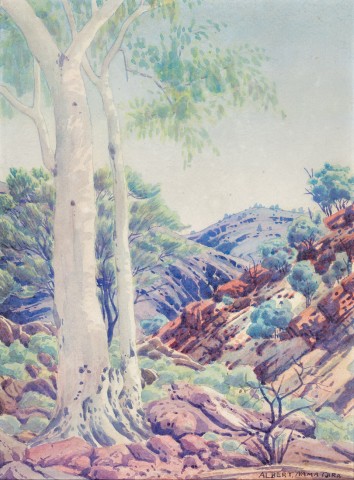GHOST GUM AND VALLEY, MACDONNELL RANGES, c.1950
ALBERT NAMATJIRA
watercolour on paper
37.5 x 27.5 cm
signed lower right: ALBERT NAMATJIRA
bears inscription verso: 20
Tom Silver Fine Art, Sydney
Private collection, Melbourne, acquired from the above c.1988
‘…Many years ago an Aboriginal man from central Australia, Albert Namatjira, became very famous as a painter. Using Western watercolour techniques he painted many landscapes. But what non-aboriginal people didn’t understand, or chose not to understand, was that he was painting his country, the land of the Arrernte people. He was demonstrating to the rest of the world the living title held by his people to the lands they had been on for thousands of years.’1
Although an accomplished craftsman producing poker work decorated woomeras, boomerangs and wooden plaques, it was not until viewing an exhibition of watercolours by Victorian artists Rex Battarbee and John Gardner at the Hermannsburg Mission in 1934, that Albert Namatjira truly embarked upon painting as a profession. Immediately captivated by the medium, Namatjira pleaded to be taught watercolour techniques and eventually Battarbee agreed to Namatjira accompanying him on two month-long expeditions in 1936 through the Palm Valley and MacDonnell Range areas. And thus began the cultural exchange that was to become a defining feature of their long relationship; Battarbee instructing Namatjira about the Western technique of watercolour painting, and in turn, Namatjira imparting his sacred knowledge about the subjects they were to paint, namely the land of the Western Aranda people, his ‘Dreaming’ place. So impressive was Namatjira’s skill that Battarbee remarked after only a brief period, ‘I felt he had done so well that he had no more to learn from me about colour’2. Success and recognition soon followed and Namatjira was launched into the spotlight as a cultural ‘icon’ - internationally acclaimed and admired for his innovative, vibrantly coloured desert landscapes that encouraged ‘new ways of seeing the Centre.’3
With its striking aesthetic appeal and embedded, multi-layered possibilities of meaning, MacDonnell Ranges, c.1950 offers a superb example of Namatjira’s achievements, encapsulating the highly unique vision that has subsequently inspired generations of Indigenous and non-Indigenous artists alike across Australia. As Belinda Croft elucidates, however, ‘Albert’s Gift’ was more far-reaching than simply the tangible legacy of his art, ‘…more than the sum parts of watercolour paints on paper. It is an essence that resides in the strength of Namatjira’s work – his courage, his sorrow, his spirituality – in these days of ‘reconciliation’, but most of all, in the spiritual heritage of every indigenous person in Australia.’3
1. Galarrwuy Yunupingu cited in ‘The black/white conflict’ in Caruana, W. (ed.), Windows on the Dreaming, Australian National Gallery, Canberra, Ellsyd Press, Sydney, 1989, p. 14
2. Morphy, H., Aboriginal Art, Phaidon Press, London, 1998, p. 268
3. Croft, B., ‘Albert’s Gift’ in French, A., Seeing the Centre: The Art of Albert Namatjira, 1902 – 1959, National Gallery of Australia, Canberra, 2002, p. 148
VERONICA ANGELATOS
